Asset Management, Design for Maintainability, and Reliability
VerifiedAdded on 2023/01/04
|11
|1876
|86
Report
AI Summary
This report delves into the intricacies of asset management, exploring how organizations derive value from their assets. It examines the expectations and needs of stakeholders concerning asset maintenance, emphasizing the importance of skilled personnel and documented systems. The report outlines the scope of maintenance organizations in meeting these expectations, detailing the roles of key personnel like engineering heads and maintenance superintendents. It further discusses the significance of leadership commitment and support for risk-based maintenance management, along with the application of life cycle costing (LCC) in decision-making processes. The report identifies challenges faced by maintenance engineers, such as skill gaps and data limitations, while proposing potential enhancements for asset management practices. The assignment, aligned with MREGC5001, requires a focus on real-world data, cost-benefit analysis, and effective communication of maintenance strategies from a business perspective. The report emphasizes the importance of quality over quantity in data management and highlights the need for benchmarking and standardized systems to improve performance.
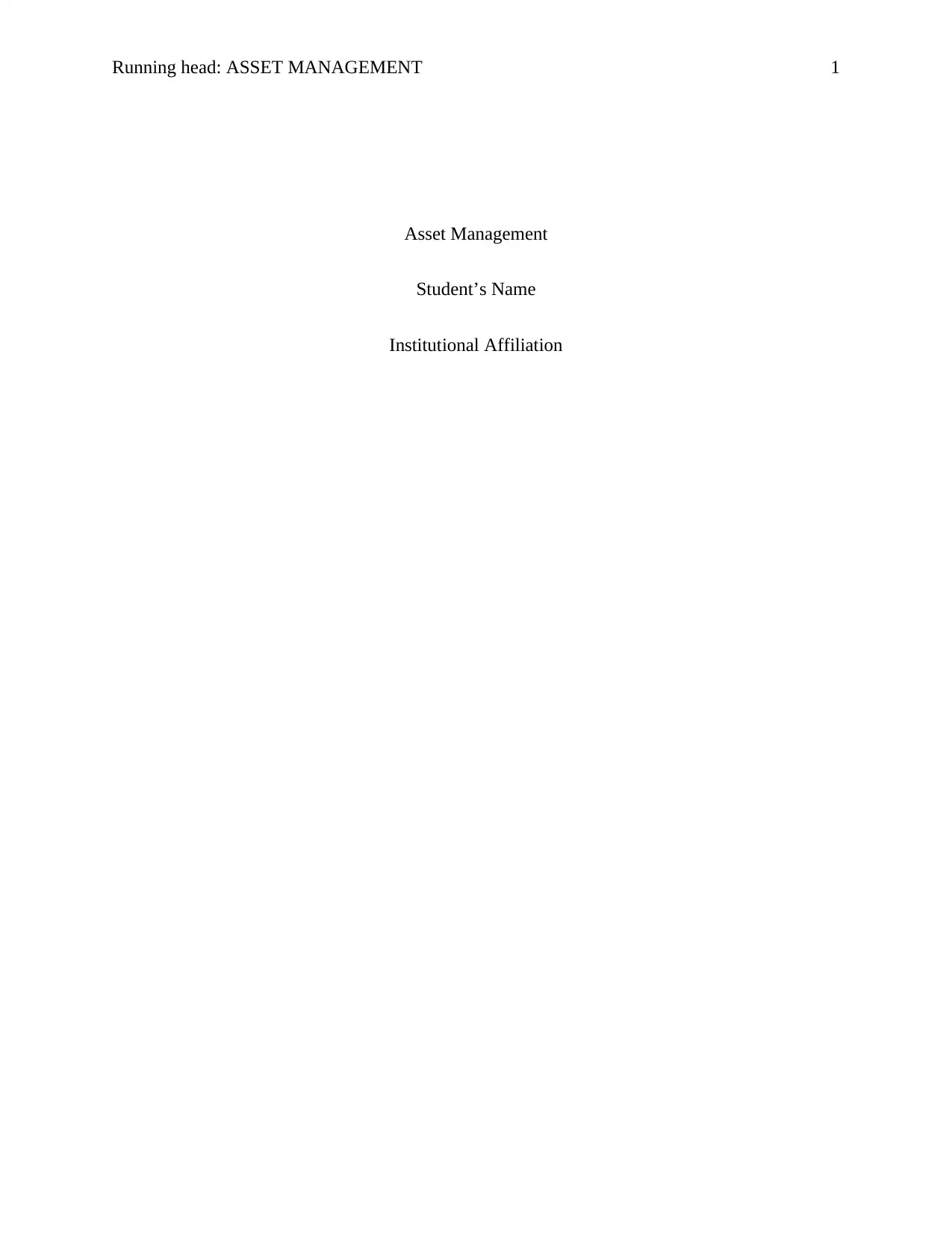
Running head: ASSET MANAGEMENT 1
Asset Management
Student’s Name
Institutional Affiliation
Asset Management
Student’s Name
Institutional Affiliation
Paraphrase This Document
Need a fresh take? Get an instant paraphrase of this document with our AI Paraphraser
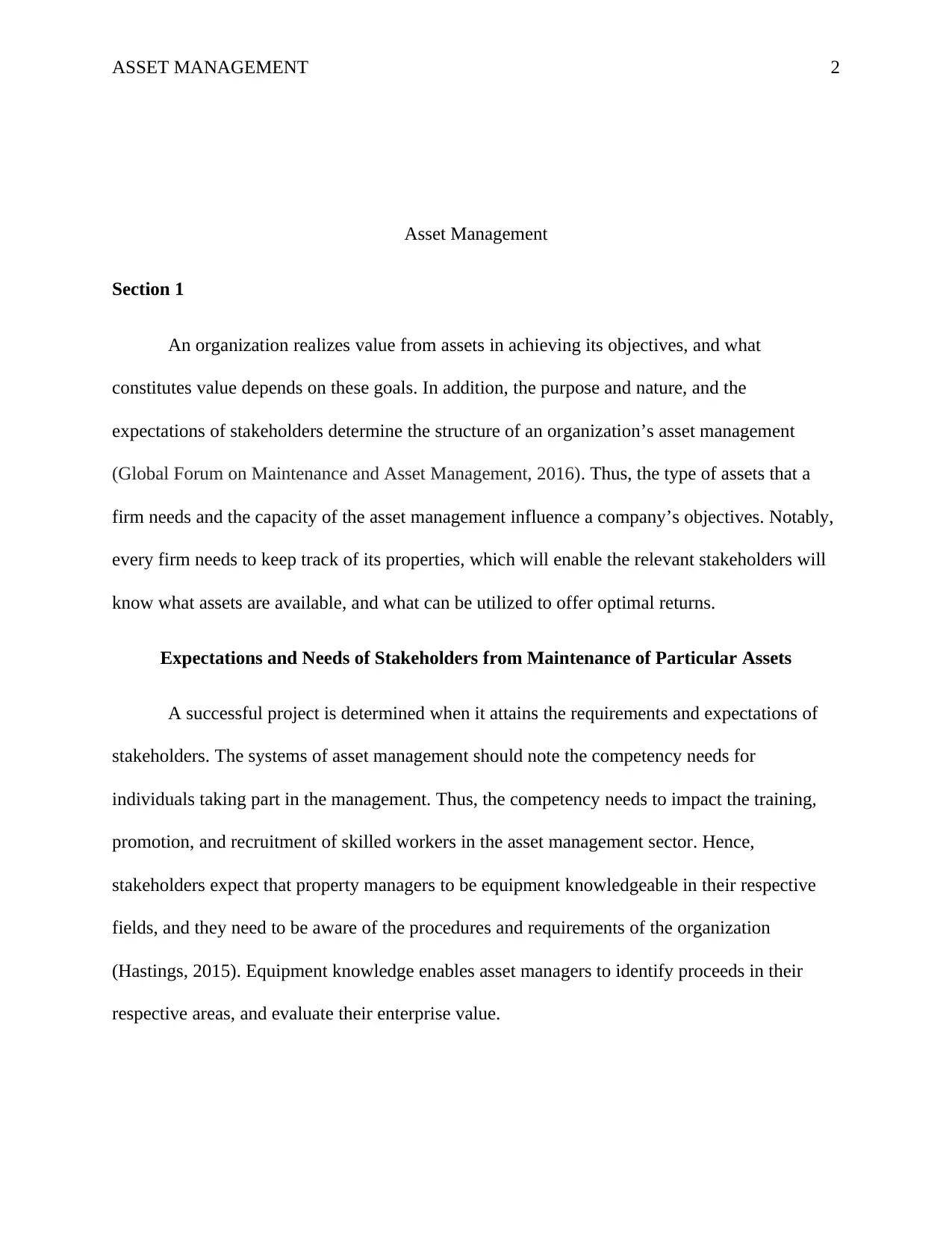
ASSET MANAGEMENT 2
Asset Management
Section 1
An organization realizes value from assets in achieving its objectives, and what
constitutes value depends on these goals. In addition, the purpose and nature, and the
expectations of stakeholders determine the structure of an organization’s asset management
(Global Forum on Maintenance and Asset Management, 2016). Thus, the type of assets that a
firm needs and the capacity of the asset management influence a company’s objectives. Notably,
every firm needs to keep track of its properties, which will enable the relevant stakeholders will
know what assets are available, and what can be utilized to offer optimal returns.
Expectations and Needs of Stakeholders from Maintenance of Particular Assets
A successful project is determined when it attains the requirements and expectations of
stakeholders. The systems of asset management should note the competency needs for
individuals taking part in the management. Thus, the competency needs to impact the training,
promotion, and recruitment of skilled workers in the asset management sector. Hence,
stakeholders expect that property managers to be equipment knowledgeable in their respective
fields, and they need to be aware of the procedures and requirements of the organization
(Hastings, 2015). Equipment knowledge enables asset managers to identify proceeds in their
respective areas, and evaluate their enterprise value.
Asset Management
Section 1
An organization realizes value from assets in achieving its objectives, and what
constitutes value depends on these goals. In addition, the purpose and nature, and the
expectations of stakeholders determine the structure of an organization’s asset management
(Global Forum on Maintenance and Asset Management, 2016). Thus, the type of assets that a
firm needs and the capacity of the asset management influence a company’s objectives. Notably,
every firm needs to keep track of its properties, which will enable the relevant stakeholders will
know what assets are available, and what can be utilized to offer optimal returns.
Expectations and Needs of Stakeholders from Maintenance of Particular Assets
A successful project is determined when it attains the requirements and expectations of
stakeholders. The systems of asset management should note the competency needs for
individuals taking part in the management. Thus, the competency needs to impact the training,
promotion, and recruitment of skilled workers in the asset management sector. Hence,
stakeholders expect that property managers to be equipment knowledgeable in their respective
fields, and they need to be aware of the procedures and requirements of the organization
(Hastings, 2015). Equipment knowledge enables asset managers to identify proceeds in their
respective areas, and evaluate their enterprise value.

ASSET MANAGEMENT 3
The asset managers need to analyze the impact of each stakeholder on the organization’s
objectives, which may be linked to their expectations and influence level. Thus, understanding
how each sponsor defines the firm’s success, especially crucial influencers can assist the asset
manager in achieving their aspirations (O’Loughlin, n.d.). Generally, stakeholders expect every
skill employee in the company to understand their duties depending on its magnitude and
structure.
The Scope of the Maintenance Organization to Meet Stakeholder’s Expectations
An organization needs to understand its sponsors who affect its outcomes and activities.
Additionally, the firm should understand who will contribute resources such as capital,
resources, and tools, and who may benefit from the outputs of the business. Moreover, the
workload influences the size and shape of the maintenance organization, such as administrative
structure, resource structure, and systems. The resource structure aims at attaining the most
appropriate resource used for practical work quality and responses. Below are the skilled
personnel that influences engineering and maintenance roles in asset management that meet
stakeholder expectations:
Engineering Heads
These may include project engineers and managers. They ensure that technical provisions are
compiled, and implemented according to the requirements of the stakeholders (Hastings, 2015).
Also, they are responsible for approving the appointment of technical authorities.
Maintenance Superintendent
In large companies, there may be numerous maintenance superintendent for various
departments such as mechanical, and electrical sectors. The role of this skilled personnel is to
The asset managers need to analyze the impact of each stakeholder on the organization’s
objectives, which may be linked to their expectations and influence level. Thus, understanding
how each sponsor defines the firm’s success, especially crucial influencers can assist the asset
manager in achieving their aspirations (O’Loughlin, n.d.). Generally, stakeholders expect every
skill employee in the company to understand their duties depending on its magnitude and
structure.
The Scope of the Maintenance Organization to Meet Stakeholder’s Expectations
An organization needs to understand its sponsors who affect its outcomes and activities.
Additionally, the firm should understand who will contribute resources such as capital,
resources, and tools, and who may benefit from the outputs of the business. Moreover, the
workload influences the size and shape of the maintenance organization, such as administrative
structure, resource structure, and systems. The resource structure aims at attaining the most
appropriate resource used for practical work quality and responses. Below are the skilled
personnel that influences engineering and maintenance roles in asset management that meet
stakeholder expectations:
Engineering Heads
These may include project engineers and managers. They ensure that technical provisions are
compiled, and implemented according to the requirements of the stakeholders (Hastings, 2015).
Also, they are responsible for approving the appointment of technical authorities.
Maintenance Superintendent
In large companies, there may be numerous maintenance superintendent for various
departments such as mechanical, and electrical sectors. The role of this skilled personnel is to
⊘ This is a preview!⊘
Do you want full access?
Subscribe today to unlock all pages.

Trusted by 1+ million students worldwide
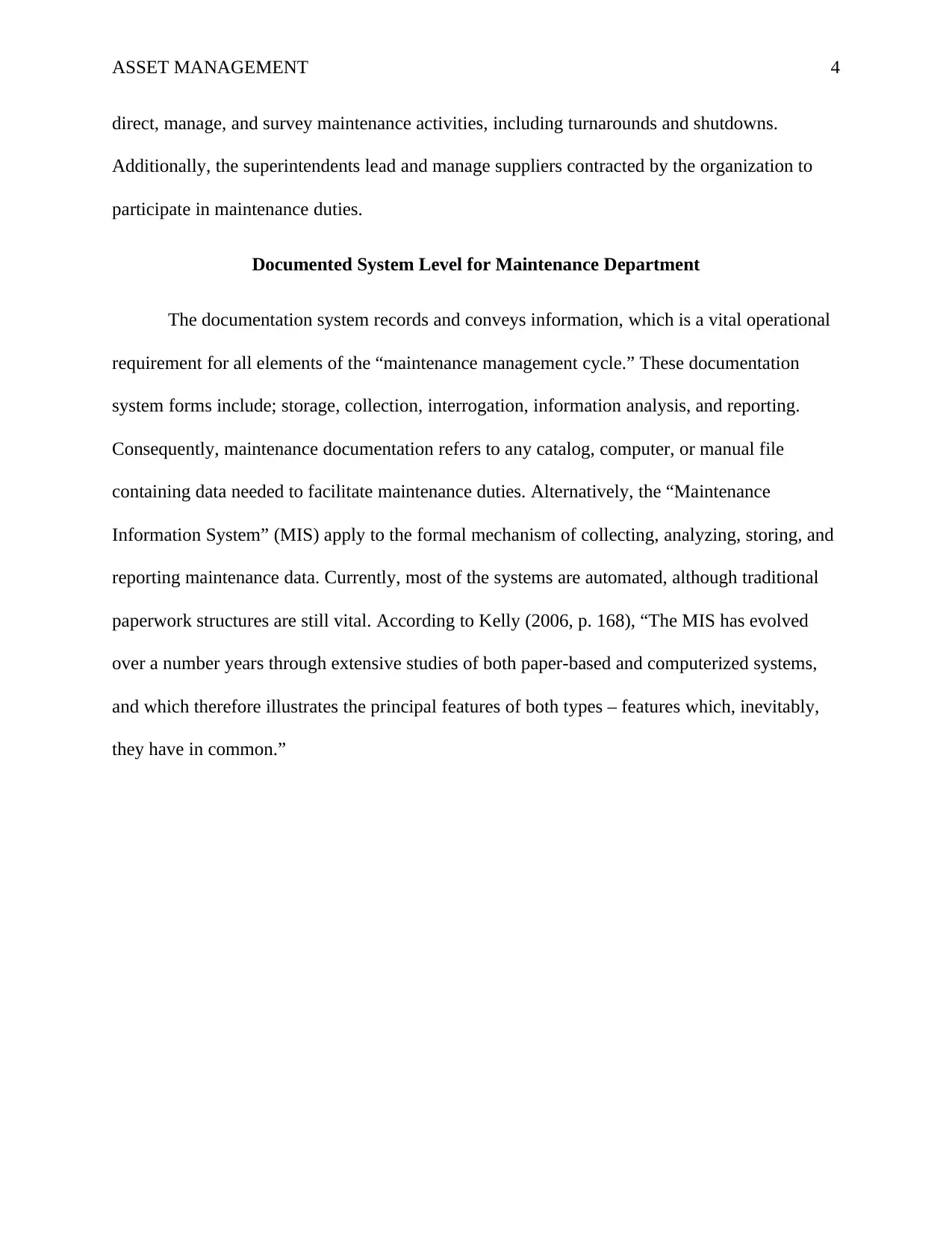
ASSET MANAGEMENT 4
direct, manage, and survey maintenance activities, including turnarounds and shutdowns.
Additionally, the superintendents lead and manage suppliers contracted by the organization to
participate in maintenance duties.
Documented System Level for Maintenance Department
The documentation system records and conveys information, which is a vital operational
requirement for all elements of the “maintenance management cycle.” These documentation
system forms include; storage, collection, interrogation, information analysis, and reporting.
Consequently, maintenance documentation refers to any catalog, computer, or manual file
containing data needed to facilitate maintenance duties. Alternatively, the “Maintenance
Information System” (MIS) apply to the formal mechanism of collecting, analyzing, storing, and
reporting maintenance data. Currently, most of the systems are automated, although traditional
paperwork structures are still vital. According to Kelly (2006, p. 168), “The MIS has evolved
over a number years through extensive studies of both paper-based and computerized systems,
and which therefore illustrates the principal features of both types – features which, inevitably,
they have in common.”
direct, manage, and survey maintenance activities, including turnarounds and shutdowns.
Additionally, the superintendents lead and manage suppliers contracted by the organization to
participate in maintenance duties.
Documented System Level for Maintenance Department
The documentation system records and conveys information, which is a vital operational
requirement for all elements of the “maintenance management cycle.” These documentation
system forms include; storage, collection, interrogation, information analysis, and reporting.
Consequently, maintenance documentation refers to any catalog, computer, or manual file
containing data needed to facilitate maintenance duties. Alternatively, the “Maintenance
Information System” (MIS) apply to the formal mechanism of collecting, analyzing, storing, and
reporting maintenance data. Currently, most of the systems are automated, although traditional
paperwork structures are still vital. According to Kelly (2006, p. 168), “The MIS has evolved
over a number years through extensive studies of both paper-based and computerized systems,
and which therefore illustrates the principal features of both types – features which, inevitably,
they have in common.”
Paraphrase This Document
Need a fresh take? Get an instant paraphrase of this document with our AI Paraphraser

ASSET MANAGEMENT 5
Figure 1: A maintenance documentation structure
The systems can be made up of various interrelated several elements associated with the
documentation systems in the maintenance department. These plant inventory, maintenance
database and schedule, condition monitoring, short-term and shutdown work planning, and
control, and maintenance control. Figure 2 indicates some of the documentation forms that
enable the operation of all elements of maintenance management. Contrary, figure 3 illustrates
the potential connection between systems of documentation maintenance, and other systems of
organization data.
Figure 1: A maintenance documentation structure
The systems can be made up of various interrelated several elements associated with the
documentation systems in the maintenance department. These plant inventory, maintenance
database and schedule, condition monitoring, short-term and shutdown work planning, and
control, and maintenance control. Figure 2 indicates some of the documentation forms that
enable the operation of all elements of maintenance management. Contrary, figure 3 illustrates
the potential connection between systems of documentation maintenance, and other systems of
organization data.
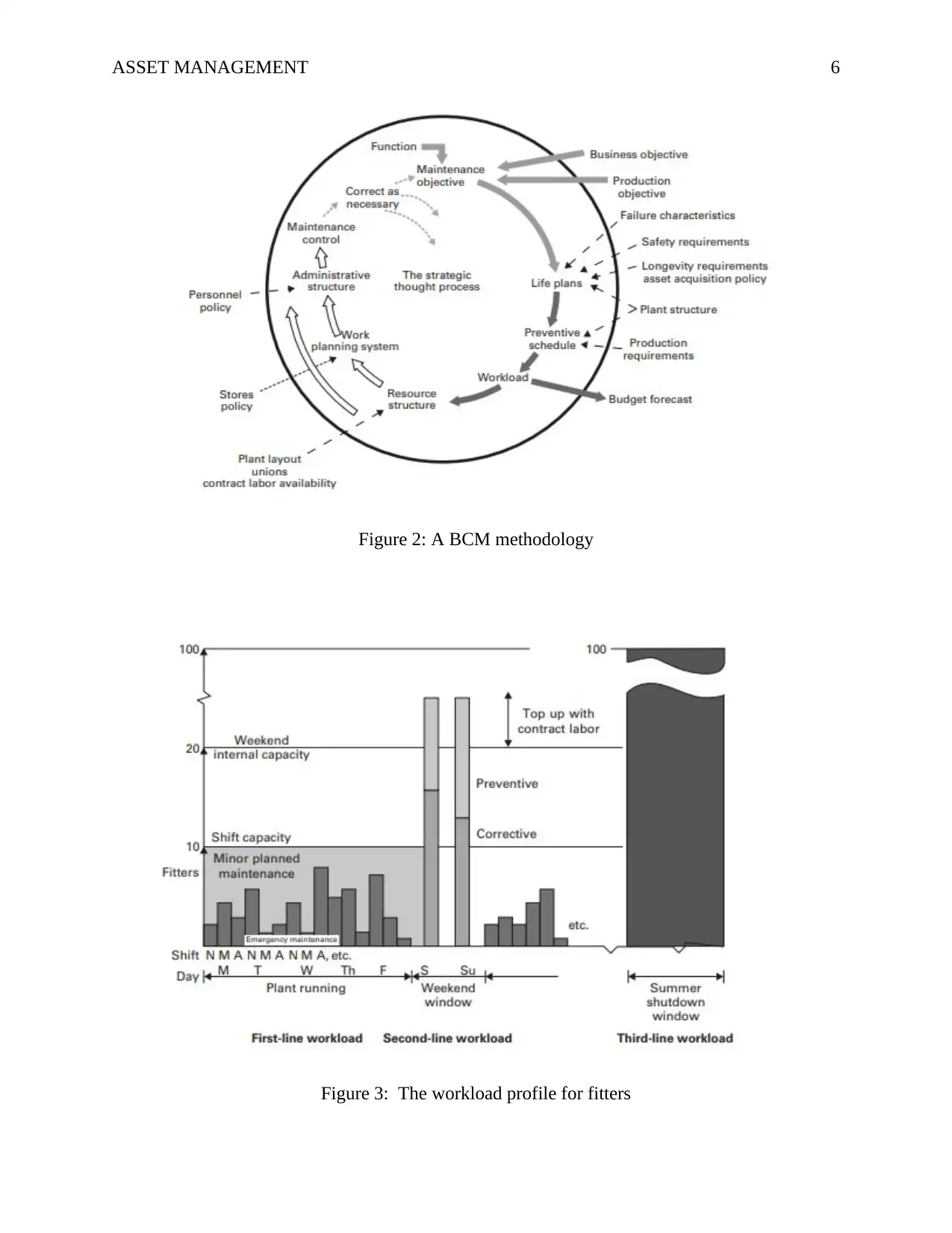
ASSET MANAGEMENT 6
Figure 2: A BCM methodology
Figure 3: The workload profile for fitters
Figure 2: A BCM methodology
Figure 3: The workload profile for fitters
⊘ This is a preview!⊘
Do you want full access?
Subscribe today to unlock all pages.

Trusted by 1+ million students worldwide
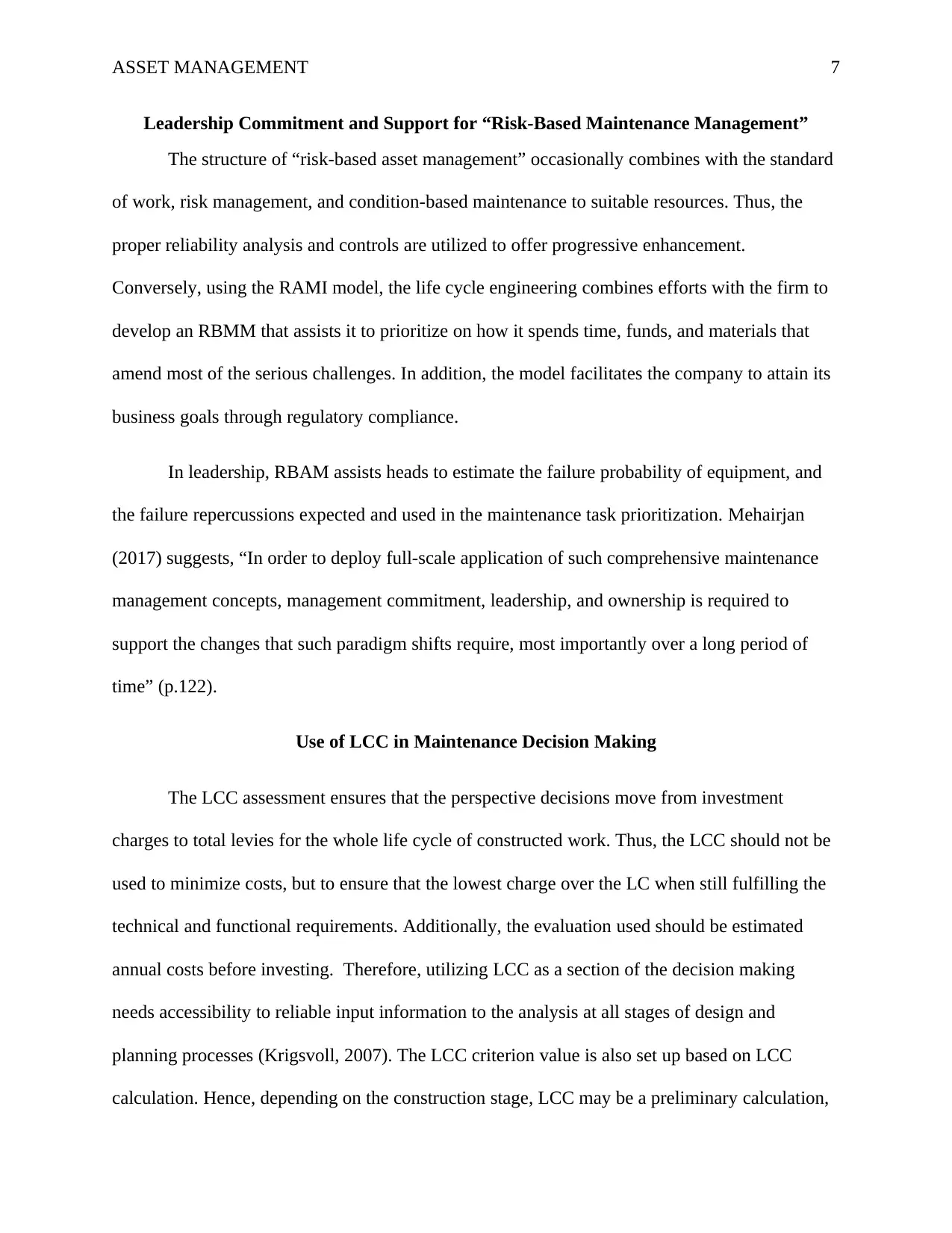
ASSET MANAGEMENT 7
Leadership Commitment and Support for “Risk-Based Maintenance Management”
The structure of “risk-based asset management” occasionally combines with the standard
of work, risk management, and condition-based maintenance to suitable resources. Thus, the
proper reliability analysis and controls are utilized to offer progressive enhancement.
Conversely, using the RAMI model, the life cycle engineering combines efforts with the firm to
develop an RBMM that assists it to prioritize on how it spends time, funds, and materials that
amend most of the serious challenges. In addition, the model facilitates the company to attain its
business goals through regulatory compliance.
In leadership, RBAM assists heads to estimate the failure probability of equipment, and
the failure repercussions expected and used in the maintenance task prioritization. Mehairjan
(2017) suggests, “In order to deploy full-scale application of such comprehensive maintenance
management concepts, management commitment, leadership, and ownership is required to
support the changes that such paradigm shifts require, most importantly over a long period of
time” (p.122).
Use of LCC in Maintenance Decision Making
The LCC assessment ensures that the perspective decisions move from investment
charges to total levies for the whole life cycle of constructed work. Thus, the LCC should not be
used to minimize costs, but to ensure that the lowest charge over the LC when still fulfilling the
technical and functional requirements. Additionally, the evaluation used should be estimated
annual costs before investing. Therefore, utilizing LCC as a section of the decision making
needs accessibility to reliable input information to the analysis at all stages of design and
planning processes (Krigsvoll, 2007). The LCC criterion value is also set up based on LCC
calculation. Hence, depending on the construction stage, LCC may be a preliminary calculation,
Leadership Commitment and Support for “Risk-Based Maintenance Management”
The structure of “risk-based asset management” occasionally combines with the standard
of work, risk management, and condition-based maintenance to suitable resources. Thus, the
proper reliability analysis and controls are utilized to offer progressive enhancement.
Conversely, using the RAMI model, the life cycle engineering combines efforts with the firm to
develop an RBMM that assists it to prioritize on how it spends time, funds, and materials that
amend most of the serious challenges. In addition, the model facilitates the company to attain its
business goals through regulatory compliance.
In leadership, RBAM assists heads to estimate the failure probability of equipment, and
the failure repercussions expected and used in the maintenance task prioritization. Mehairjan
(2017) suggests, “In order to deploy full-scale application of such comprehensive maintenance
management concepts, management commitment, leadership, and ownership is required to
support the changes that such paradigm shifts require, most importantly over a long period of
time” (p.122).
Use of LCC in Maintenance Decision Making
The LCC assessment ensures that the perspective decisions move from investment
charges to total levies for the whole life cycle of constructed work. Thus, the LCC should not be
used to minimize costs, but to ensure that the lowest charge over the LC when still fulfilling the
technical and functional requirements. Additionally, the evaluation used should be estimated
annual costs before investing. Therefore, utilizing LCC as a section of the decision making
needs accessibility to reliable input information to the analysis at all stages of design and
planning processes (Krigsvoll, 2007). The LCC criterion value is also set up based on LCC
calculation. Hence, depending on the construction stage, LCC may be a preliminary calculation,
Paraphrase This Document
Need a fresh take? Get an instant paraphrase of this document with our AI Paraphraser
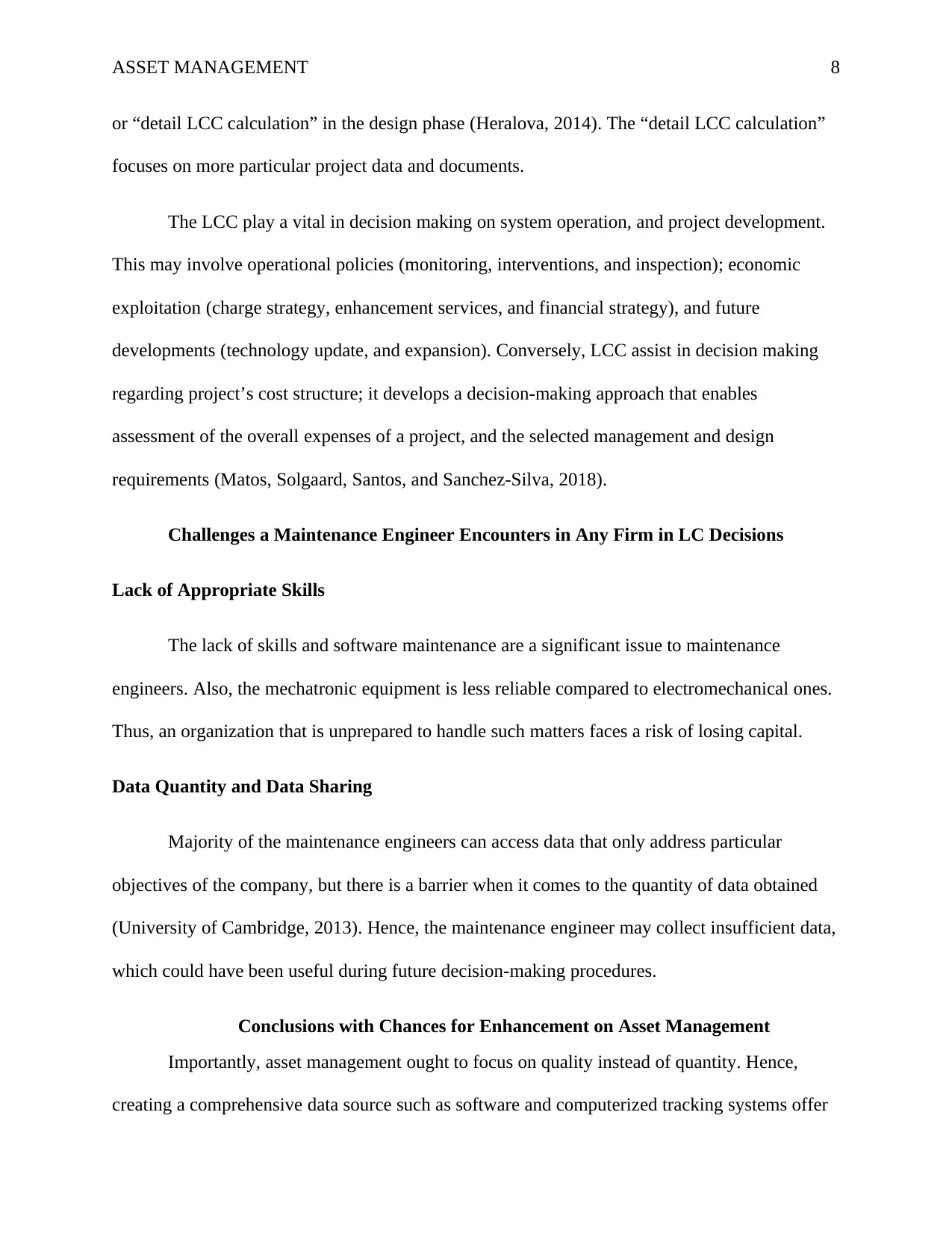
ASSET MANAGEMENT 8
or “detail LCC calculation” in the design phase (Heralova, 2014). The “detail LCC calculation”
focuses on more particular project data and documents.
The LCC play a vital in decision making on system operation, and project development.
This may involve operational policies (monitoring, interventions, and inspection); economic
exploitation (charge strategy, enhancement services, and financial strategy), and future
developments (technology update, and expansion). Conversely, LCC assist in decision making
regarding project’s cost structure; it develops a decision-making approach that enables
assessment of the overall expenses of a project, and the selected management and design
requirements (Matos, Solgaard, Santos, and Sanchez-Silva, 2018).
Challenges a Maintenance Engineer Encounters in Any Firm in LC Decisions
Lack of Appropriate Skills
The lack of skills and software maintenance are a significant issue to maintenance
engineers. Also, the mechatronic equipment is less reliable compared to electromechanical ones.
Thus, an organization that is unprepared to handle such matters faces a risk of losing capital.
Data Quantity and Data Sharing
Majority of the maintenance engineers can access data that only address particular
objectives of the company, but there is a barrier when it comes to the quantity of data obtained
(University of Cambridge, 2013). Hence, the maintenance engineer may collect insufficient data,
which could have been useful during future decision-making procedures.
Conclusions with Chances for Enhancement on Asset Management
Importantly, asset management ought to focus on quality instead of quantity. Hence,
creating a comprehensive data source such as software and computerized tracking systems offer
or “detail LCC calculation” in the design phase (Heralova, 2014). The “detail LCC calculation”
focuses on more particular project data and documents.
The LCC play a vital in decision making on system operation, and project development.
This may involve operational policies (monitoring, interventions, and inspection); economic
exploitation (charge strategy, enhancement services, and financial strategy), and future
developments (technology update, and expansion). Conversely, LCC assist in decision making
regarding project’s cost structure; it develops a decision-making approach that enables
assessment of the overall expenses of a project, and the selected management and design
requirements (Matos, Solgaard, Santos, and Sanchez-Silva, 2018).
Challenges a Maintenance Engineer Encounters in Any Firm in LC Decisions
Lack of Appropriate Skills
The lack of skills and software maintenance are a significant issue to maintenance
engineers. Also, the mechatronic equipment is less reliable compared to electromechanical ones.
Thus, an organization that is unprepared to handle such matters faces a risk of losing capital.
Data Quantity and Data Sharing
Majority of the maintenance engineers can access data that only address particular
objectives of the company, but there is a barrier when it comes to the quantity of data obtained
(University of Cambridge, 2013). Hence, the maintenance engineer may collect insufficient data,
which could have been useful during future decision-making procedures.
Conclusions with Chances for Enhancement on Asset Management
Importantly, asset management ought to focus on quality instead of quantity. Hence,
creating a comprehensive data source such as software and computerized tracking systems offer
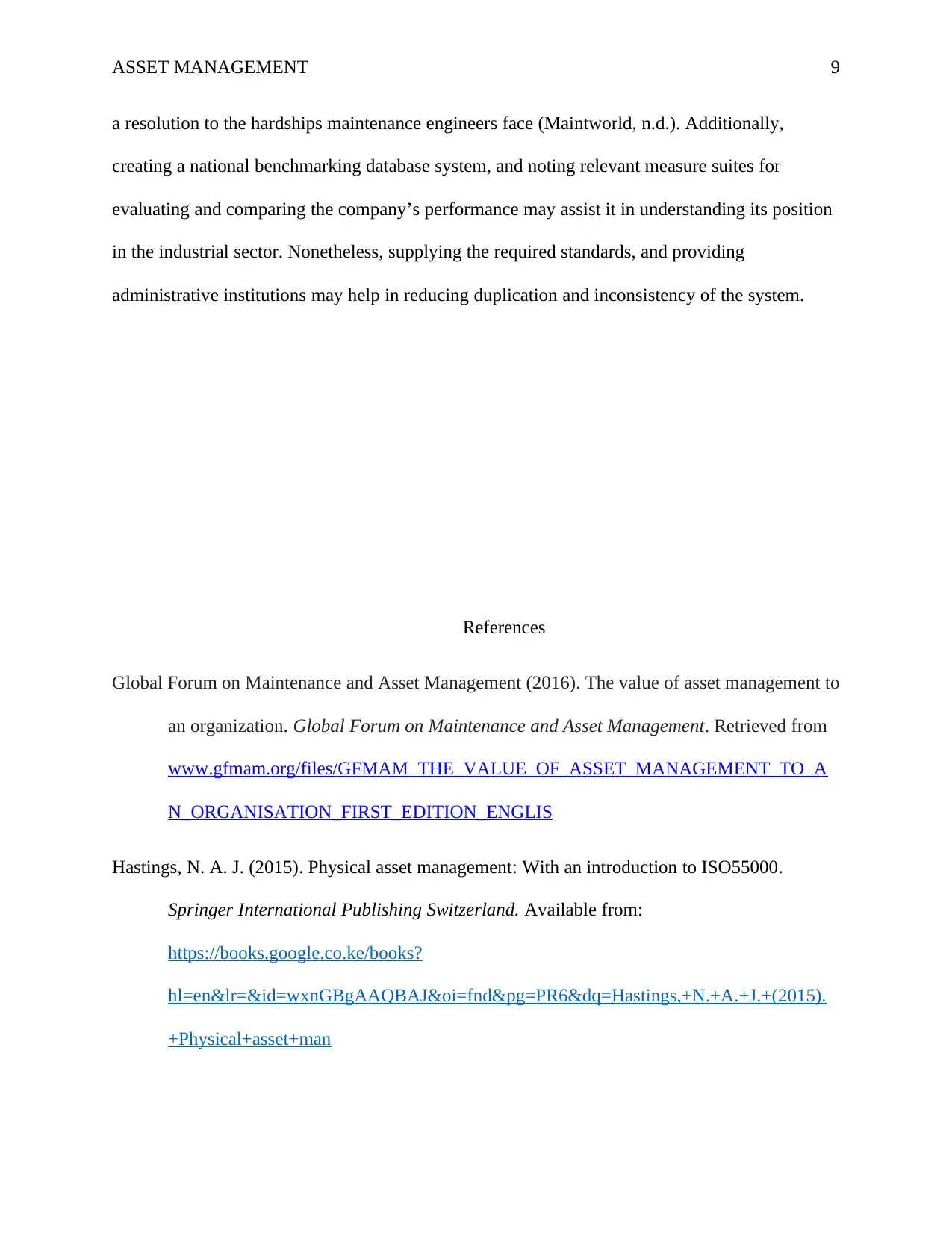
ASSET MANAGEMENT 9
a resolution to the hardships maintenance engineers face (Maintworld, n.d.). Additionally,
creating a national benchmarking database system, and noting relevant measure suites for
evaluating and comparing the company’s performance may assist it in understanding its position
in the industrial sector. Nonetheless, supplying the required standards, and providing
administrative institutions may help in reducing duplication and inconsistency of the system.
References
Global Forum on Maintenance and Asset Management (2016). The value of asset management to
an organization. Global Forum on Maintenance and Asset Management. Retrieved from
www.gfmam.org/files/GFMAM_THE_VALUE_OF_ASSET_MANAGEMENT_TO_A
N_ORGANISATION_FIRST_EDITION_ENGLIS
Hastings, N. A. J. (2015). Physical asset management: With an introduction to ISO55000.
Springer International Publishing Switzerland. Available from:
https://books.google.co.ke/books?
hl=en&lr=&id=wxnGBgAAQBAJ&oi=fnd&pg=PR6&dq=Hastings,+N.+A.+J.+(2015).
+Physical+asset+man
a resolution to the hardships maintenance engineers face (Maintworld, n.d.). Additionally,
creating a national benchmarking database system, and noting relevant measure suites for
evaluating and comparing the company’s performance may assist it in understanding its position
in the industrial sector. Nonetheless, supplying the required standards, and providing
administrative institutions may help in reducing duplication and inconsistency of the system.
References
Global Forum on Maintenance and Asset Management (2016). The value of asset management to
an organization. Global Forum on Maintenance and Asset Management. Retrieved from
www.gfmam.org/files/GFMAM_THE_VALUE_OF_ASSET_MANAGEMENT_TO_A
N_ORGANISATION_FIRST_EDITION_ENGLIS
Hastings, N. A. J. (2015). Physical asset management: With an introduction to ISO55000.
Springer International Publishing Switzerland. Available from:
https://books.google.co.ke/books?
hl=en&lr=&id=wxnGBgAAQBAJ&oi=fnd&pg=PR6&dq=Hastings,+N.+A.+J.+(2015).
+Physical+asset+man
⊘ This is a preview!⊘
Do you want full access?
Subscribe today to unlock all pages.

Trusted by 1+ million students worldwide
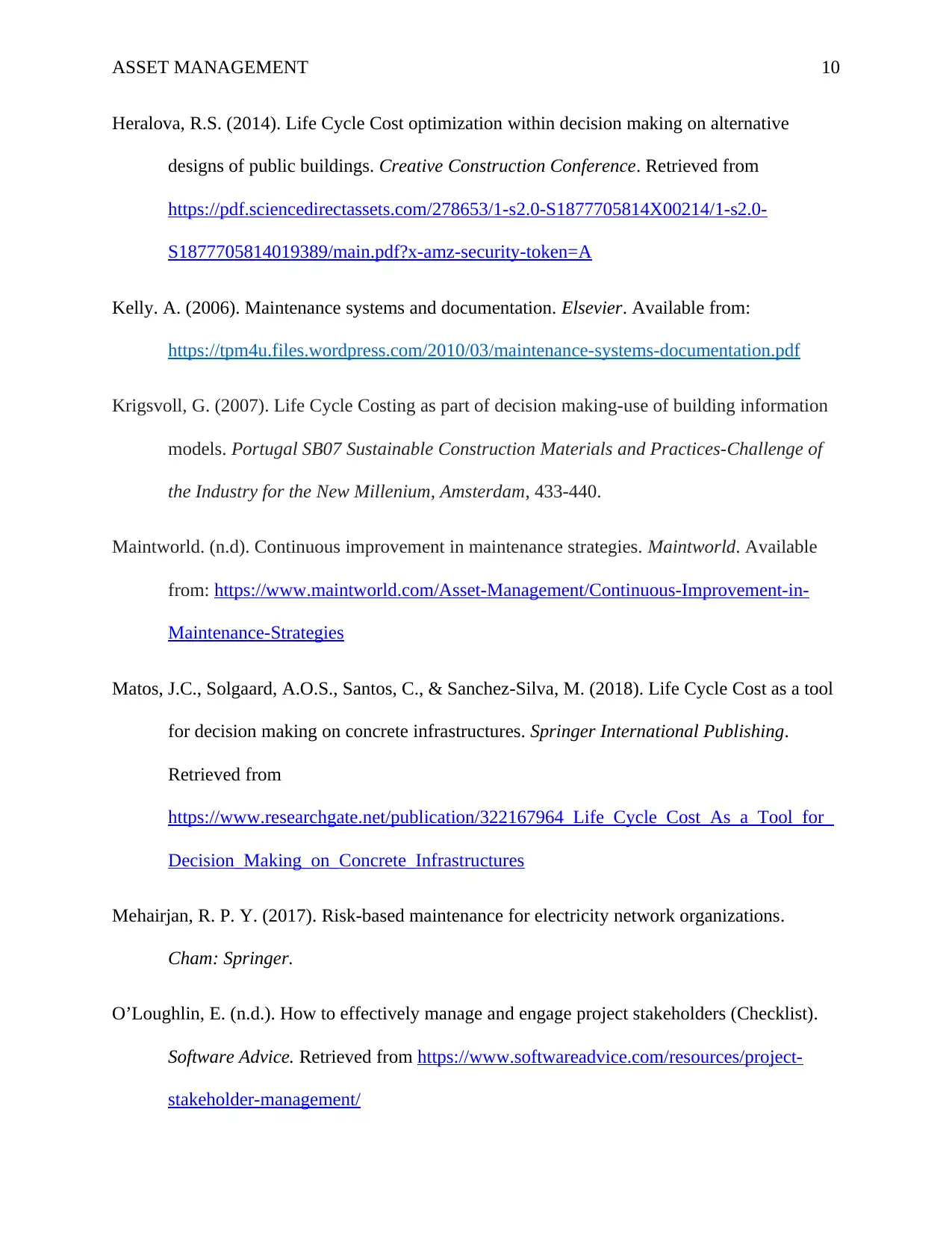
ASSET MANAGEMENT 10
Heralova, R.S. (2014). Life Cycle Cost optimization within decision making on alternative
designs of public buildings. Creative Construction Conference. Retrieved from
https://pdf.sciencedirectassets.com/278653/1-s2.0-S1877705814X00214/1-s2.0-
S1877705814019389/main.pdf?x-amz-security-token=A
Kelly. A. (2006). Maintenance systems and documentation. Elsevier. Available from:
https://tpm4u.files.wordpress.com/2010/03/maintenance-systems-documentation.pdf
Krigsvoll, G. (2007). Life Cycle Costing as part of decision making-use of building information
models. Portugal SB07 Sustainable Construction Materials and Practices-Challenge of
the Industry for the New Millenium, Amsterdam, 433-440.
Maintworld. (n.d). Continuous improvement in maintenance strategies. Maintworld. Available
from: https://www.maintworld.com/Asset-Management/Continuous-Improvement-in-
Maintenance-Strategies
Matos, J.C., Solgaard, A.O.S., Santos, C., & Sanchez-Silva, M. (2018). Life Cycle Cost as a tool
for decision making on concrete infrastructures. Springer International Publishing.
Retrieved from
https://www.researchgate.net/publication/322167964_Life_Cycle_Cost_As_a_Tool_for_
Decision_Making_on_Concrete_Infrastructures
Mehairjan, R. P. Y. (2017). Risk-based maintenance for electricity network organizations.
Cham: Springer.
O’Loughlin, E. (n.d.). How to effectively manage and engage project stakeholders (Checklist).
Software Advice. Retrieved from https://www.softwareadvice.com/resources/project-
stakeholder-management/
Heralova, R.S. (2014). Life Cycle Cost optimization within decision making on alternative
designs of public buildings. Creative Construction Conference. Retrieved from
https://pdf.sciencedirectassets.com/278653/1-s2.0-S1877705814X00214/1-s2.0-
S1877705814019389/main.pdf?x-amz-security-token=A
Kelly. A. (2006). Maintenance systems and documentation. Elsevier. Available from:
https://tpm4u.files.wordpress.com/2010/03/maintenance-systems-documentation.pdf
Krigsvoll, G. (2007). Life Cycle Costing as part of decision making-use of building information
models. Portugal SB07 Sustainable Construction Materials and Practices-Challenge of
the Industry for the New Millenium, Amsterdam, 433-440.
Maintworld. (n.d). Continuous improvement in maintenance strategies. Maintworld. Available
from: https://www.maintworld.com/Asset-Management/Continuous-Improvement-in-
Maintenance-Strategies
Matos, J.C., Solgaard, A.O.S., Santos, C., & Sanchez-Silva, M. (2018). Life Cycle Cost as a tool
for decision making on concrete infrastructures. Springer International Publishing.
Retrieved from
https://www.researchgate.net/publication/322167964_Life_Cycle_Cost_As_a_Tool_for_
Decision_Making_on_Concrete_Infrastructures
Mehairjan, R. P. Y. (2017). Risk-based maintenance for electricity network organizations.
Cham: Springer.
O’Loughlin, E. (n.d.). How to effectively manage and engage project stakeholders (Checklist).
Software Advice. Retrieved from https://www.softwareadvice.com/resources/project-
stakeholder-management/
Paraphrase This Document
Need a fresh take? Get an instant paraphrase of this document with our AI Paraphraser
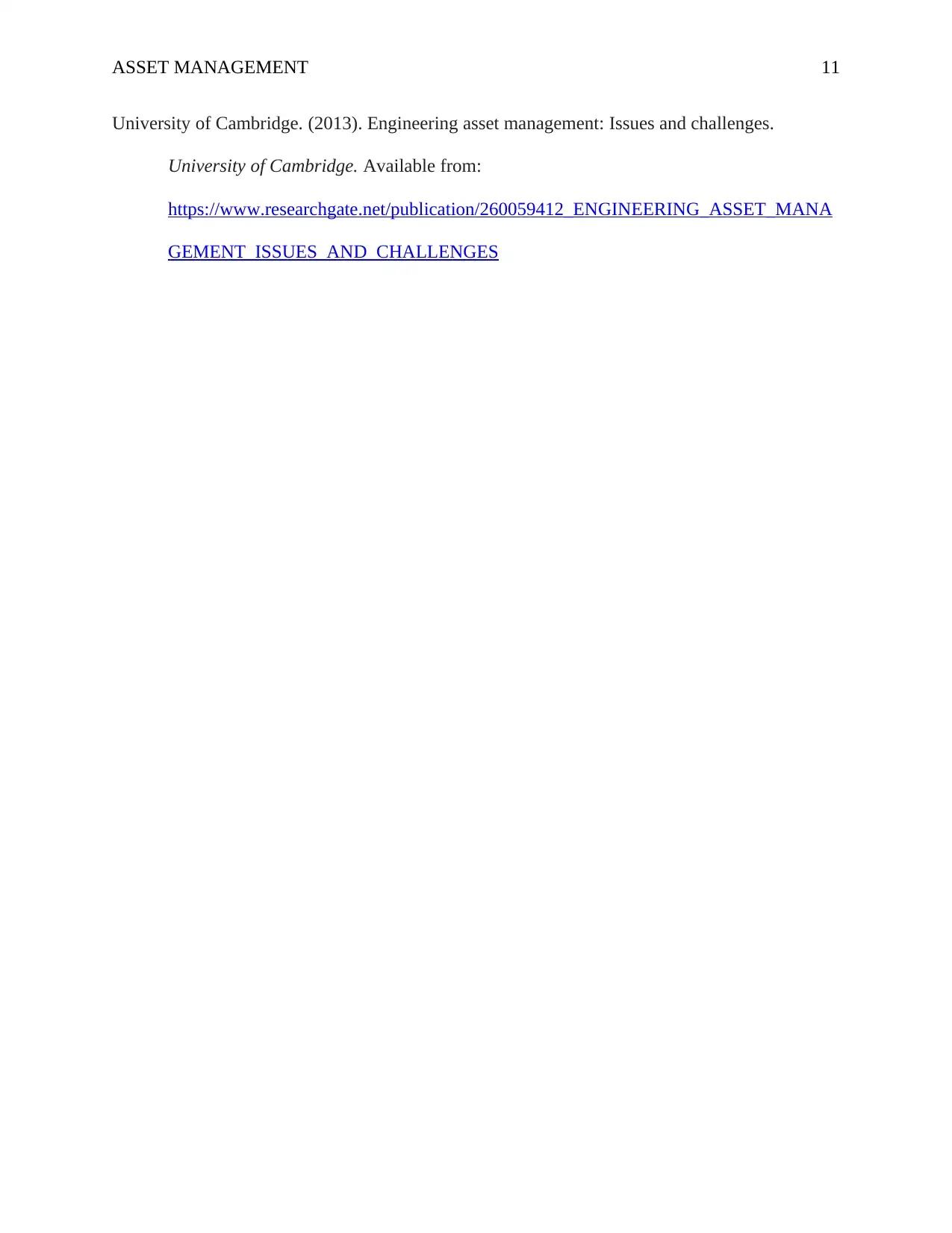
ASSET MANAGEMENT 11
University of Cambridge. (2013). Engineering asset management: Issues and challenges.
University of Cambridge. Available from:
https://www.researchgate.net/publication/260059412_ENGINEERING_ASSET_MANA
GEMENT_ISSUES_AND_CHALLENGES
University of Cambridge. (2013). Engineering asset management: Issues and challenges.
University of Cambridge. Available from:
https://www.researchgate.net/publication/260059412_ENGINEERING_ASSET_MANA
GEMENT_ISSUES_AND_CHALLENGES
1 out of 11
Related Documents
Your All-in-One AI-Powered Toolkit for Academic Success.
+13062052269
info@desklib.com
Available 24*7 on WhatsApp / Email
![[object Object]](/_next/static/media/star-bottom.7253800d.svg)
Unlock your academic potential
Copyright © 2020–2025 A2Z Services. All Rights Reserved. Developed and managed by ZUCOL.





